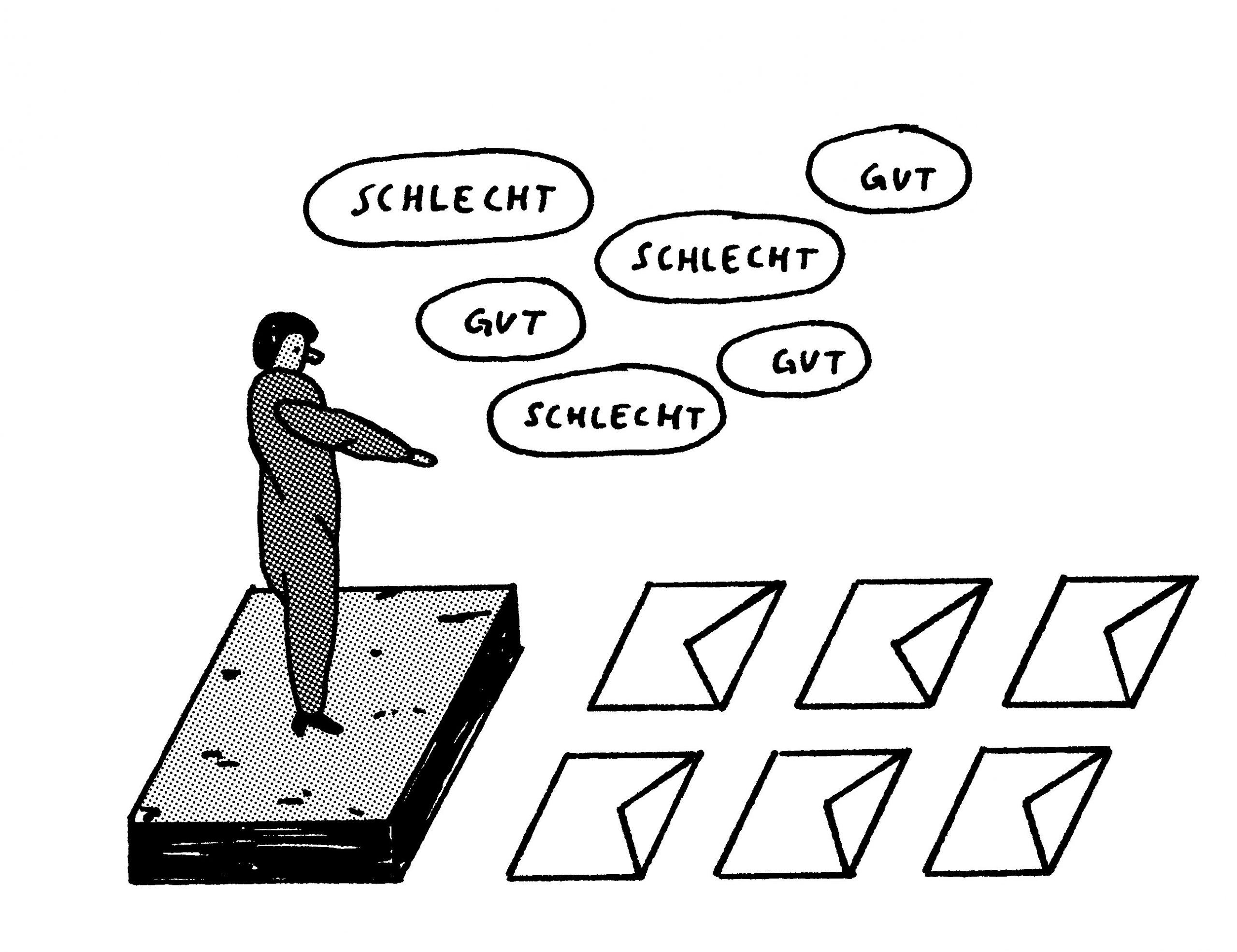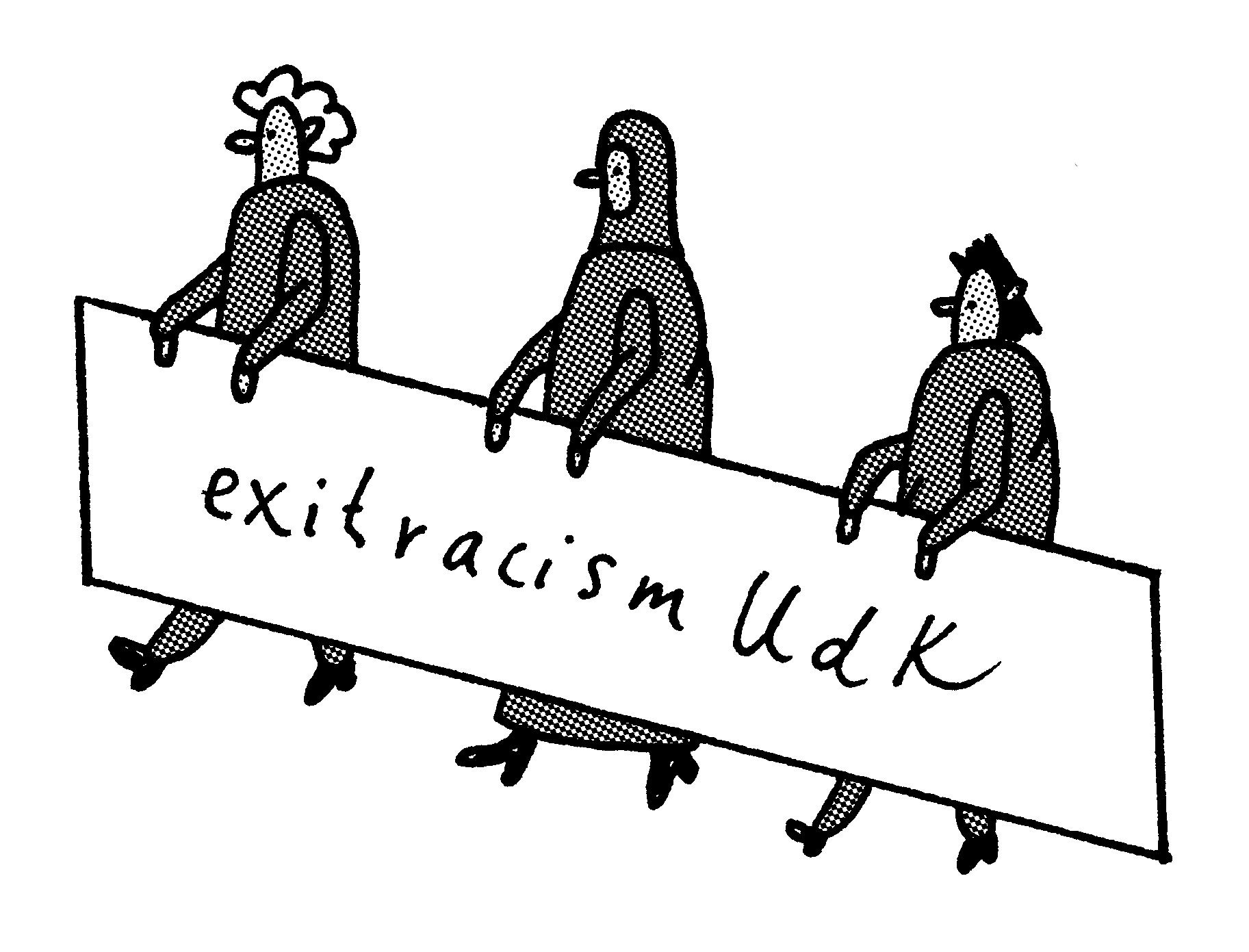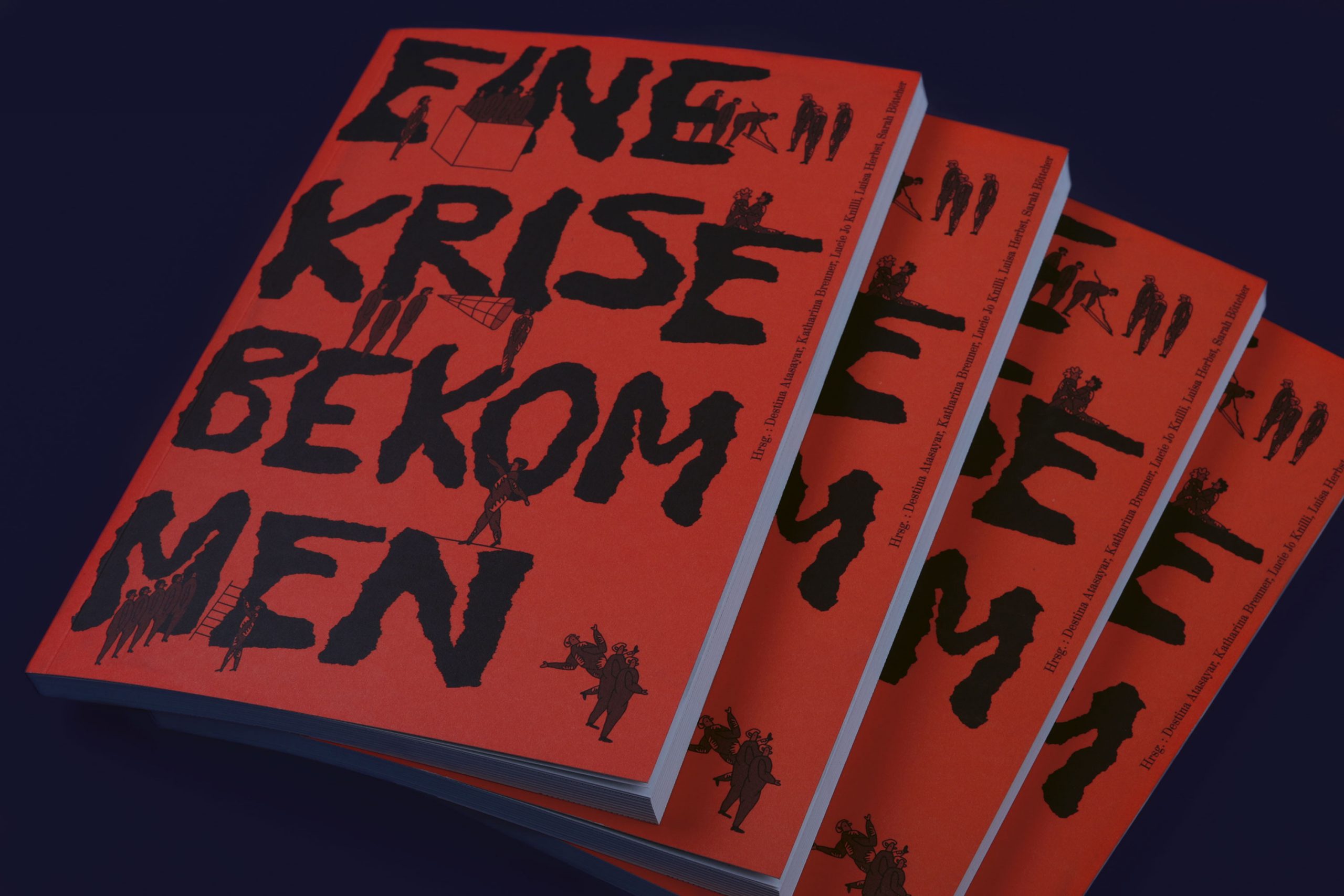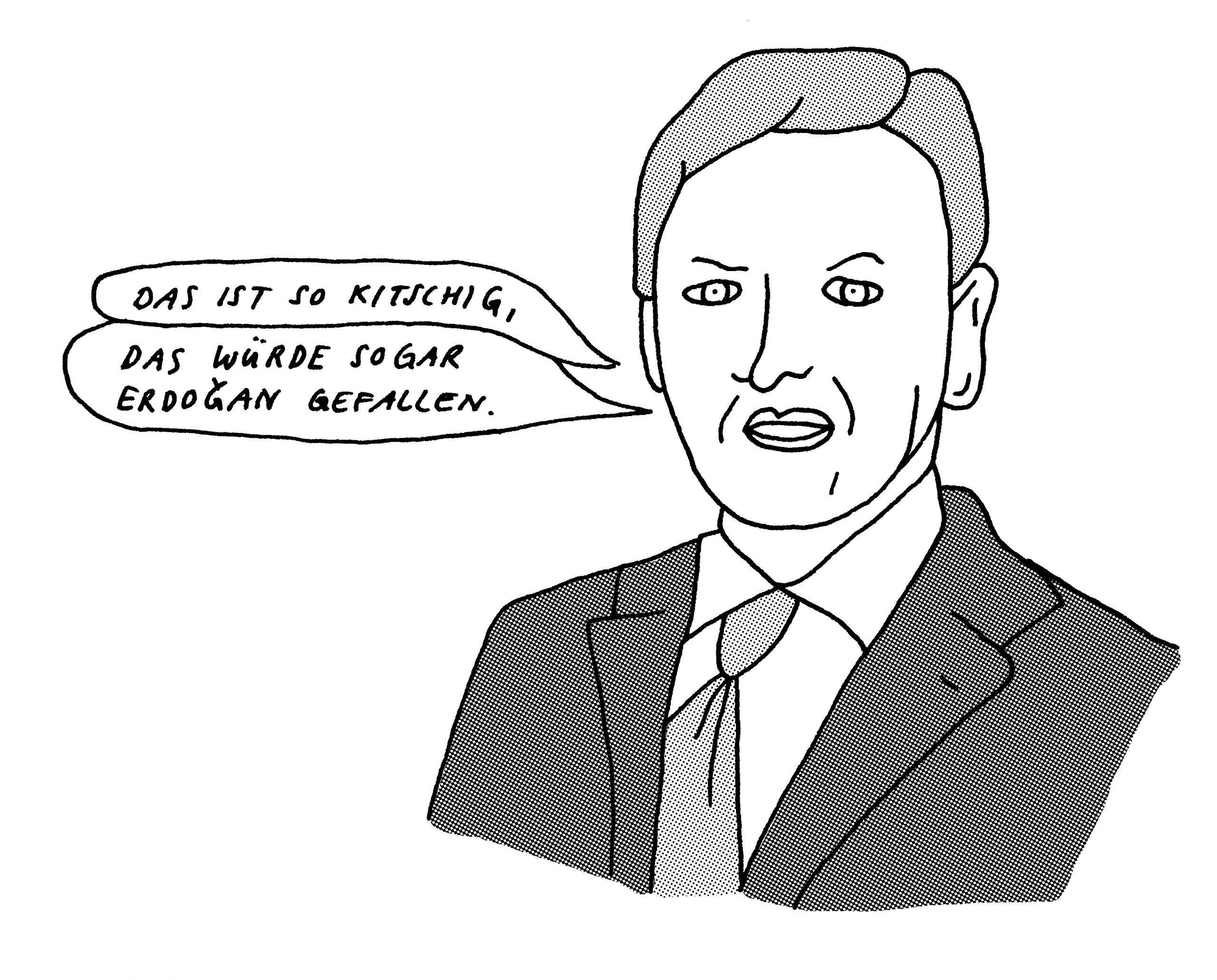„Das ist so kitschig, das würde sogar Erdoğan gefallen“, sagte mir ein alter weißer Mann, der an der HfG Offenbach1Die Hochschule für Gestaltung Offenbach bietet die Studiengänge Kunst und Design an und genießt mit einem aufwendigen Aufnahmeverfahren und etwa 750 Studierenden einen hervorragenden Ruf. als Professor für Markenstrategie unterrichtete. Als ich mich 2017 an deutschen Kunstuniversitäten bewarb, wurde ich mit autoritären Machtdemonstrationen, Rassismus, Sexismus und toxischer Männlichkeit konfrontiert – und stelle mir nun die Frage, inwiefern die Strukturen von Kunstuniversitäten pädagogisch verändert werden müssen, um solchen Dynamiken entgegenzuwirken.
Bevor es überhaupt losging
Um sich für den Studiengang Kunst an der HfG Offenbach zu bewerben, braucht es Zeit: Für die Bewerbungsunterlagen, ein Portfolio mit mindestens 30 Facharbeiten, die künstlerische Eignungsprüfung und mehrere Mappensichtungen im Voraus, die dringend empfohlen werden. Dort schauen sich Professor*innen der Hochschule vor anderen potentiellen Bewerber*innen die Mappen an und sollen eigentlich konstruktives Feedback geben. Bei solch einer Mappensichtung befand ich mich 2017 und wartete, bis ich dran war. Vor mir bewarben sich Menschen mit Abschlüssen von verschiedenen Kunstakademien und zeigten ihre Werke und Lebensläufe. Der zuständige Professor jedoch machte sich genüsslich über die Deutschkenntnisse von Bewerber*innen lustig, anstatt eine Einschätzung oder Kritik der Arbeiten anzubieten: Er fragte eine Südkoreanerin, wieso die Illustrationen denn nicht im Manga-Stil gestaltet wurden. „Manga passt doch so gut zu dir“, bemerkte er. Ihre Fotografiearbeit zu Rotweinsorten wurde kommentiert mit „Gibt’s bei euch in Korea überhaupt Wein?“ Einer anderen Person sagte er „Das ist ja so bedrückend wie euer China“, woraufhin diese konterte: „Ich bin aus Japan.“ Während die Arbeiten von männlich gelesenen Personen mit unkommentiertem Kopfnicken bestätigt wurden, mussten sich viele Bewerberinnen solche Sticheleien anhören.
Und nun war ich dran – meine Gefühlslage war eine unangenehme Mischung aus Nervosität und unterdrückter Wut. Bevor es überhaupt losging, fragte er mich penetrant nach meiner ‚Herkunft‘ – meine Antwort „Ich bin aus Frankfurt, gleich hier um die Ecke“ reichte natürlich nicht. Nach einer Weile gab ich nach. „Aha“ antwortete er, und während des Sichtens meiner Mappe wiederholte er dann viermal: „Das ist so langweilig, so kitschig, dass es sogar Erdoğan gefallen würde“ und schaute mich provokant an. Es war der Teil meiner Mappe, welcher nicht der ,westlichen‘ Ästhetik entsprach. „Das hat doch gar nichts mit Kunst zu tun“ sagte ich perplex. „Ja, genau deswegen“ antwortete er willkürlich.

Eine falsche Assoziation, die im Übrigen (unabhängig von der diskriminierenden Aussage) nicht einmal auf meine Familiengeschichte und Antwort zutrifft. Ich erinnere mich, dass ich trotzdem den gesamten Rückweg „nicht weinen, nicht weinen, nicht weinen“ in meinem Kopf wiederholte. Und darauf folgend: „Wieso habe ich nicht besser gekontert oder wenigstens den Anderen geholfen?“ Peinlich berührt realisierte ich, dass ich nach diesen Machtdemonstrationen keine Zivilcourage geleistet habe, weil ich einen guten Eindruck hinterlassen wollte, um an der Universität angenommen zu werden. Mein zukünftiger Studienort als auch die Bewertung meiner Arbeiten hingen davon ab, wie er mich wahrnimmt: Ich rebellierte nicht, um nicht als wütende Migrantin abgestempelt zu werden.
Diese Dynamik funktionierte, da sich der Professor als einzige Person im Raum zu den Arbeiten äußern durfte – nach anderen Meinungen wurde weder gefragt, noch waren sie erwünscht. Von seinem privilegierten Standpunkt aus spielte er mit der Unsicherheit der Bewerber*innen: Die hierarchische Situation wurde für vermeintliche Witze und unprofessionelle Bemerkungen genutzt. Welcher Ästhetikbegriff hierbei eine Rolle spielte, wurde durch das Betonen der assoziierten ‚kulturellen‘ Zugehörigkeit ebenso klar: Deine ‚Herkunft‘ bestimmt über deine Mappe, und nicht andersherum. Entweder passt du zur HfG, oder deine Arbeit ist zu ‚fremd‘ und ‚kitschig‘.
Von Zuschreibungen und Betroffenheit
Die Vorstellung, als etwas abgestempelt zu werden, oder auch Sich-Denken-Was-Der-Andere-Von-Einem-Denkt, öffnet die Büchse des internalisierten Wahnsinns. Hierbei werden nicht nur die eigenen politische Haltungen, sondern auch Emotionen unterdrückt oder hinterfragt. Das Dilemma, sich von zugeschriebenen Rollen (hier: die wütende Migrantin, die keine Abweisung verkraften kann) zu distanzieren und zugleich antidiskriminatorische Arbeit leisten zu wollen, beschreibt Sara Ahmed mit der Figur des Feminist Killjoys: Eine Spielverderberin*, die, egal wie sie spricht, als Feministin* wahrgenommen wird, die ständig Probleme verursacht. Und dadurch selbst das Problem verkörpert.2Ahmed, Sara: Living a Feminist Life, Duke Univ. Press (2017)
Am Beispiel der Mappensichtung in Offenbach – wie auch in vielen anderen Fällen – ist aber der zu beachtende Punkt, dass von Diskriminierung Betroffene nicht die Pflicht tragen, den*die Täter*in zu konfrontieren. Denn letztere haben in den Strukturen der Kunstuniversitäten die Möglichkeiten, ihre Macht und Überlegenheit zu demonstrieren – und das nutzen sie oftmals auch. So entsteht eine Wissenshierarchie, in der überwiegend westeuropäische Künste wertgeschätzt und legitimiert werden. Wenn Lehrende eine ästhetische Sprache auferlegen, reproduziert das weiterhin die bestehenden Strukturen, was bei Lernenden negative Folgen im Studienalltag auslöst. Laut Ira Shor zählen dazu Selbstzweifel, Empörung, Frustration und Langeweile: „These […] are commonly generated when an official culture and language are imposed from the top down, ignoring the students’ themes, languages, conditions, and diverse cultures.“3Shor, Ira: Empowering Education: Critical Teaching for Social Change (1992) 23

Das unbenannte Vorwissen und Verständnis einer ästhetischen Sprache formulieren sich unter anderem wie folgt: „Diesen Künstler müssten Sie aber kennen!“ Es wird angenommen und vorausgesetzt, dass Studierende ähnlich sozialisiert sind wie Lehrende, sei es eine vergleichbare Bildungssituation oder ein bestimmtes Kunstverständnis und ‚Allgemeinwissen‘. Dies äußert sich oft durch Abfragen von Referenzen bis hin zur ästhetischen Wertung, deren Begründung oftmals nicht genau benannt werden kann. Der Standpunkt, der hier als lehrende Person eingenommen wird, ist geprägt durch die eigene Bewertung und Wahrnehmung von Künsten.
Diese unausgesprochenen Normen können nur jene verstehen, die auch in einem spezifischen kulturellen und akademischen Kontext aufgewachsen sind, wodurch sich die Bildungsungleichheit verstärkt. Gerade Kunsthochschulen, die sich als zukunftsorientiert, vielseitig und offen verstehen, bestärken diese Dynamik durch fehlende transkulturelle Kompetenzen.
Dass Studierende of Color besonders betroffen sind in von Diskriminierung geprägten Situationen, zeigen die vielen anonymen Rassismuserfahrungsberichte, die an der Universität der Künste Berlin im Rahmen der Protestaktion #exitracismUDK gesammelt und an den Universitätsfassaden4exitracismUdK ist ein offener Brief mit formulierten Forderungen an die Universität der Künste Berlin, und eine Antwort auf die „mangelnde Solidarität von Seiten der Lehrenden.“ https:// … Continue reading gezeigt wurden. So schrieb ein*e Queer Student of Color: „Den Lehrenden fehlte es an emotionaler, pädagogischer, sowie (trans)kultureller Sensibilität.“5Ausschnitt eines Erfahrungsberichtes, welcher durch exitracismUdK in der UdK-Ausstellung KUNST RAUM STADT am 16-17.7.2020 gezeigt wurde. „2018 wurde ich für den Master an der UdK angenommen. … Continue reading
Die Vorstellung, dass lediglich Betroffene die Aufgabe tragen, Diskriminierungen zu behandeln oder aufzuarbeiten, funktioniert nicht: Es ist ignorant und verwerflich, sich der Verantwortung zu entziehen, bestehende Strukturen weiterzuführen – und von ihnen zu profitieren. Denn nach bell hooks6bell hooks ist Literaturwissenschaftlerin, Professorin, Aktivistin und Autorin intersektionaler, anti-rassistischer und feministischer Bücher. ist Bildung politisch und findet in einem spezifischen politischen Kontext statt, verbunden mit einem politischen Ziel, auch wenn dieses nicht explizit hervorgehoben wird.7Kazeem-Kamiński, Belinda: Engaged Pedagogy: Antidiskriminatorisches Lehren und Lernen bei bell hooks (2016). Lehrende treffen politische Entscheidungen, wenn sie lehren, was im Kontrast zu dem verbreiteten Bild einer objektiven und universellen Bildung steht.

Ein Beispiel nehmen an bell hooks
bell hooks formuliert hierbei pädagogische Praktiken, die auf8ebd. Lehrende sowie Lernende zutreffen: Das Bewusstsein davon, dass Bildung politisch ist und dass politische Entscheidungen getroffen werden, was und wie gelehrt wird; die Anerkennung davon, dass der gesellschaftliche Kontext diskriminierende Strukturen aufweist; und das kritische Hinterfragen der eigenen Position.9Eine Positionierung in bestehenden Machtverhältnissen können Angaben zu unter anderem Geschlechtsidentitäten, sexuelle Identitäten, Behinderungen, Rassismuserfahrungen oder ökonomische … Continue reading Denn Bildung kann und sollte auch ein Werkzeug sein, um Rassismus, (Hetero)sexismus, Ableismus, Antisemitismus und viele weitere Diskriminierungsformen zu überwinden: Indem es zu einer Auseinandersetzung kommt und internalisierte Vorstellungen aufgebrochen werden, geht der Raum des Lernens über die Wissensaneignung hinaus. Im ‚participatory space‘, also einem Raum, in dem die Teilhabe jeder*jedes Einzelnen möglich ist, wird kritisches Denken trainiert. Das bedeutet auch, dass im Gegensatz zur häufigen Forderung, objektive Fakten zu nutzen, auch individuelle Erfahrungen anerkannt, wertgeschätzt und nicht von der Theoriearbeit getrennt werden. Erst daraus können wertvolle Diskurse und eine feministische, antirassistische, dekoloniale und antiklassistische Lehre entstehen. Kurz: eine kollektive, kritische Praxis.10Kazeem-Kamiński, Belinda: Engaged Pedagogy: Antidiskriminatorisches Lehren und Lernen bei bell hooks (2016)
Design, aber dekolonial.
Im Kontext der Kunstuniversität bedeutet eine kollektive, kritische Praxis auch das Überdenken der Lehrinhalte. Diskurse um Künste, Ästhetik und Design müssen unter anderem antirassistisch, feministisch und dekolonial neu gedacht werden. Das kann nur geschehen, indem sich zuerst mit der (vor allem kolonialen) Geschichte auseinandergesetzt wird, um sie zu reflektieren und in der Lehre widerspiegeln zu lassen. Danah Abdulla erklärt, dass der Designbegriff als kontextbasierte, sich ständig entwickelnde Praxis verstanden werden muss11Abdulla, Danah: Design Otherwise: Towards a locally-centric design education curricula in Jordan (2017) – und nicht als Ergänzung für eurozentristische Kategorisierungen. Das bedeutet also nicht nur eine Erweiterung und das Hinterfragen des Lehrmaterials oder der Referenzen, sondern auch das geschichtliche Aufarbeiten und Benennen des eigenen Standpunkts: Alle sind ein Teil der Praxis der Aufrechterhaltung bestehender Machtverhältnisse – und deswegen geht es auch alle etwas an. Inwiefern das im Designkontext aufgearbeitet werden kann, zeigt die Forschungsgruppe Decolonising Design12Decolonising Design ist eine Forschungsgruppe, die analysiert, in welchen kolonialen Strukturen Gestaltung und Design agieren. (https://www.decolonisingdesign.com/) sowie Open Source13Teaching Design ist eine Open Source Bibliografie mit dem Fokus auf Designvermittlung in der Bildung aus intersektional-feministischen, dekolonialen Perspektiven. (https://teaching design.net/) Bibliografien wie Teaching Design oder Decentering Whitenes14Decentering Whiteness in Design History Resources ist eine Open Source Bibliografie, die von Designgeschichtsdozent*innen erstellt wurde als Reaktion auf die Forderungen der Studierenden, … Continue reading in Design History Resources.
Diese (oftmals von BIPoC aufgearbeiteten) Informationen sind ausreichend vorhanden – die Frage ist nur, wann und wie sich Kunstuniversitäten aufrichtig selbstkritisch reflektieren und pädagogisch neu positionieren, jenseits des oberflächlichen Diversity-Images.

Was wäre wenn?
Wenn ich an die Situation an der HfG Offenbach denke, formuliere ich viele Was-Wäre-Wenn-Überlegungen, denn in diesem Raum haben allein in einer Stunde etwa sechs Menschen Rassismus und Sexismuserfahrungen gemacht, ausgehend von einem einzigen Professor. Weder seine studentische Hilfskraft neben ihm, noch der andere Professor im selben Raum haben interveniert oder widersprochen, trotz ihrer privilegierteren Position als weiße cis Männer. Wenn der Raum partizipativer gewesen wäre, hätten mehr Menschen auf die Werke reagieren können, wodurch sich die Wissens- und Machthierarchien verschoben oder sogar aufgelöst hätten. Im Falle von diskriminierenden Äußerungen hätten sich nicht nur mehr Menschen wohlgefühlt, zu reagieren – idealerweise hätte sich der Täter nicht wohl gefühlt, diese überhaupt zu äußern. Der Professor wäre vielleicht auch nie berufen worden. Kein „Wo kommst du her“ und „Ihr macht das dort drüben doch so“ oder „Mach das mal, das passt doch so gut zu dir“, keine unterdrückte Wut, Unwohlsein und sich Hinterfragen auf dem Rückweg nach Hause. Und vor allem auch keine kreativen Hemmungen, die sich durch das gesamte Studium ziehen15Als mittlerweile zugelassene UdK-Studentin musste ich erleben, dass der Studienalltag von patriarchaler Hierarchie geprägt ist und von eurozentristischen Bewertungen abhängt, die umso … Continue reading, weil die eigene Praxis ständig mit Ästhetikdefinitionen verglichen wird, die man sich zähneknirschend aneignet, um mitreden zu können.
Was wäre also, wenn die Lehrenden an deutschen Kunstuniversitäten all diese Bauhaus-Referenzen16Die Kunst- und Designschule Bauhaus war 1919-1933 aktiv, der Einfluss auf deutsche Kunsthochschulen bleibt weiterhin stark: In meinem Studium der Visuellen Kommunikationwurde ich in vielen Seminaren … Continue reading in ihrer Lehre mit Werken von BIPoC Künstler*innen, Gestalter*innen und Wissenschaftler*innen ersetzen würden? Oder anders: Was wäre, wenn die Präsenz der sogenannten ‚Bauhaus-Frauen‘ nicht als Frauengleichstellung verstanden, sondern ihre Realität gezeigt wird – nämlich in der Weberei, und kaum in Führungspositionen? Angemessen wäre es, wenn sich der Blick auf die Künste von Grund auf verändert. Denn die Biennale ist nicht nur in Venedig.17sondern auch in: Chengdu, Kairo, Singapur, Breslau, Ulaanbaatar, Porto Alegre, Ouagadougou, Prag, Casablanca, Bukarest, Shanghai, Moskau, Gwangju, Idanha-a-Nova, Havanna, Busan, Istanbul, Athen … Continue reading

Dieser Beitrag wurde zuerst in der Publikation „Eine Krise bekommen“ veröffentlicht. Studierende der Fakultät Visuelle Kommunikation an der Universität der Künste Berlin schreiben mit kritischem Blick über die Auswirkungen der Pandemie, ambivalente Identitäten und die politische Verantwortung der Kunsthochschule. Die vierzehn Beiträge entstanden im Jahr 2020 – einer Zeit, in der die Gefährdung verwundbarer Gruppen verdeutlicht wurde – aus dem Drang, unterrepräsentierte Auseinandersetzungen und studentische Perspektiven sichtbar zu machen. Sie fordern einen differenzierteren Austausch und Anerkennung marginalisierter Perspektiven in den Räumen der Kunsthochschule – anstelle von leeren Worten zu Vielfalt und Solidarität.
„Eine krise bekommen“ ist im Buchhandel und über den UdK Verlag erhältlich. Zum Preis von 5 Euro + ggf. Versandkosten kann die Publikation hier direkt bestellt werden:
einekrisebekommen@systemli.org
Link zur Online-Publikation:
https://opus4.kobv.de/opus4-udk/frontdoor/index/index/docId/1469
Anmeldungen zur Releaseparty/Lesung am 19.7.2021:
https://tripetto.app/run/2BJWQFMCZU
References
| 1 | Die Hochschule für Gestaltung Offenbach bietet die Studiengänge Kunst und Design an und genießt mit einem aufwendigen Aufnahmeverfahren und etwa 750 Studierenden einen hervorragenden Ruf. |
|---|---|
| 2 | Ahmed, Sara: Living a Feminist Life, Duke Univ. Press (2017) |
| 3 | Shor, Ira: Empowering Education: Critical Teaching for Social Change (1992) 23 |
| 4 | exitracismUdK ist ein offener Brief mit formulierten Forderungen an die Universität der Künste Berlin, und eine Antwort auf die „mangelnde Solidarität von Seiten der Lehrenden.“ https:// exitracismudk.wordpress.com/ (abgerufen am 11.03.21) |
| 5 | Ausschnitt eines Erfahrungsberichtes, welcher durch exitracismUdK in der UdK-Ausstellung KUNST RAUM STADT am 16-17.7.2020 gezeigt wurde. „2018 wurde ich für den Master an der UdK angenommen. Was die eigentliche Erfüllung eines lange erkämpften Traumes sein sollte, entpuppte sich als richtiger Horrortrip. […] Ich hatte das Gefühl, dass man von mir verlangte, meinen multiethnischen Background so zu präsentieren wie es für sie (die Lehrenden) am verdaulichsten ist: wenig kritisch und am liebsten exotisierend. Ich hatte wirklich Schwierigkeiten, mich in diesem Umfeld einzufügen. Den Lehrenden fehlte es an emotionaler, pädagogischer, sowie (trans)kultureller Sensibilität – Queer student of color“ |
| 6 | bell hooks ist Literaturwissenschaftlerin, Professorin, Aktivistin und Autorin intersektionaler, anti-rassistischer und feministischer Bücher. |
| 7 | Kazeem-Kamiński, Belinda: Engaged Pedagogy: Antidiskriminatorisches Lehren und Lernen bei bell hooks (2016). |
| 8 | ebd. |
| 9 | Eine Positionierung in bestehenden Machtverhältnissen können Angaben zu unter anderem Geschlechtsidentitäten, sexuelle Identitäten, Behinderungen, Rassismuserfahrungen oder ökonomische Situationen sein. |
| 10 | Kazeem-Kamiński, Belinda: Engaged Pedagogy: Antidiskriminatorisches Lehren und Lernen bei bell hooks (2016) |
| 11 | Abdulla, Danah: Design Otherwise: Towards a locally-centric design education curricula in Jordan (2017) |
| 12 | Decolonising Design ist eine Forschungsgruppe, die analysiert, in welchen kolonialen Strukturen Gestaltung und Design agieren. (https://www.decolonisingdesign.com/) |
| 13 | Teaching Design ist eine Open Source Bibliografie mit dem Fokus auf Designvermittlung in der Bildung aus intersektional-feministischen, dekolonialen Perspektiven. (https://teaching design.net/) |
| 14 | Decentering Whiteness in Design History Resources ist eine Open Source Bibliografie, die von Designgeschichtsdozent*innen erstellt wurde als Reaktion auf die Forderungen der Studierenden, Perspektiven und Werke von Black, Indigenous, Latinx, Asian und anderen Designer*innen und Wissenschaftler*innen of Color in den Designkursen richtig zu repräsentieren. (https:// www.designhistorysociety.org/news/view/decentering-whiteness-in-design-history-resources) |
| 15 | Als mittlerweile zugelassene UdK-Studentin musste ich erleben, dass der Studienalltag von patriarchaler Hierarchie geprägt ist und von eurozentristischen Bewertungen abhängt, die umso persönlicher werden, da es an professioneller Distanz zu den Lehrenden fehlt (das verbreitete ‚per Du‘ dient oftmals lediglich dem Image der Universität). Meine Kursauswahl ist dementsprechend primär von den wenigen kritischen Lehrenden und kaum von den Inhalten abhängig. |
| 16 | Die Kunst- und Designschule Bauhaus war 1919-1933 aktiv, der Einfluss auf deutsche Kunsthochschulen bleibt weiterhin stark: In meinem Studium der Visuellen Kommunikationwurde ich in vielen Seminaren penetrant auf dessen Relevanz hingewiesen. |
| 17 | sondern auch in: Chengdu, Kairo, Singapur, Breslau, Ulaanbaatar, Porto Alegre, Ouagadougou, Prag, Casablanca, Bukarest, Shanghai, Moskau, Gwangju, Idanha-a-Nova, Havanna, Busan, Istanbul, Athen und vielen weiteren Orten. |

